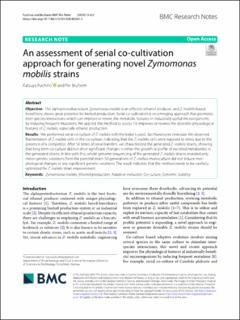| dc.contributor.author | Fuchino, Katsuya | |
| dc.contributor.author | Bruheim, Per | |
| dc.date.accessioned | 2020-11-13T12:46:49Z | |
| dc.date.available | 2020-11-13T12:46:49Z | |
| dc.date.created | 2020-11-05T16:17:01Z | |
| dc.date.issued | 2020 | |
| dc.identifier.citation | BMC Research Notes. 2020, 13 | en_US |
| dc.identifier.issn | 1756-0500 | |
| dc.identifier.uri | https://hdl.handle.net/11250/2687820 | |
| dc.description.abstract | Objective
The alphaproteobacterium Zymomonas mobilis is an efficient ethanol producer, and Z. mobilis-based biorefinery shows great potential for biofuel production. Serial co-cultivation is an emerging approach that promotes inter-species interactions which can improve or rewire the metabolic features in industrially useful microorganisms by inducing frequent mutations. We applied this method to assess if it improves or rewires the desirable physiological features of Z. mobilis, especially ethanol production.
Results
We performed serial co-culture of Z. mobilis with the baker’s yeast, Saccharomyces cerevisiae. We observed filamentation of Z. mobilis cells in the co-culture, indicating that the Z. mobilis cells were exposed to stress due to the presence of a competitor. After 50 times of serial transfers, we characterized the generated Z. mobilis strains, showing that long term co-culture did not drive significant changes in either the growth or profile of excreted metabolites in the generated strains. In line with this, whole genome sequencing of the generated Z. mobilis strains revealed only minor genetic variations from the parental strain. 50 generations of Z. mobilis monoculture did not induce morphological changes or any significant genetic variations. The result indicates that the method needs to be carefully optimized for Z. mobilis strain improvement. | en_US |
| dc.language.iso | eng | en_US |
| dc.publisher | BioMed Central | en_US |
| dc.rights | Navngivelse 4.0 Internasjonal | * |
| dc.rights.uri | http://creativecommons.org/licenses/by/4.0/deed.no | * |
| dc.title | An assessment of serial co-cultivation approach for generating novel Zymomonas mobilis strains | en_US |
| dc.type | Peer reviewed | en_US |
| dc.type | Journal article | en_US |
| dc.description.version | publishedVersion | en_US |
| dc.source.volume | 13 | en_US |
| dc.source.journal | BMC Research Notes | en_US |
| dc.identifier.doi | 10.1186/s13104-020-05261-5 | |
| dc.identifier.cristin | 1845393 | |
| dc.relation.project | Norges forskningsråd: 258657 | en_US |
| dc.description.localcode | Open Access This article is licensed under a Creative Commons Attribution 4.0 International License, which permits use, sharing, adaptation, distribution and reproduction in any medium or format, as long as you give appropriate credit to the original author(s) and the source, provide a link to the Creative Commons licence, and indicate if changes were made. The images or other third party material in this article are included in the article's Creative Commons licence, unless indicated otherwise in a credit line to the material. If material is not included in the article's Creative Commons licence and your intended use is not permitted by statutory regulation or exceeds the permitted use, you will need to obtain permission directly from the copyright holder. To view a copy of this licence, visit http://creativecommons.org/licenses/by/4.0/. The Creative Commons Public Domain Dedication waiver (http://creativecommons.org/publicdomain/zero/1.0/) applies to the data made available in this article, unless otherwise stated in a credit line to the data. | en_US |
| dc.source.articlenumber | 422 | en_US |
| cristin.ispublished | true | |
| cristin.fulltext | original | |
| cristin.qualitycode | 1 | |

